Sachsenhausen Concentration Camp
Occupancy Reports and “Extermination Operations” 1940 to 1945
The Sachsenhausen Concentration Camp – sometimes also called Oranienburg – located not far from Berlin hardly plays a role in the discussion about the “Holocaust”. If Carlo Mattogno deals with this camp in the following article, this has two reasons. First, the documents from Sachsenhausen found by him and Jürgen Graf in the State Archives of the Russian Federation, Moscow, make it possible to determine extremely precisely the camp’s strength as well as its mortality during the war. The publication of these documents is an act of positive historiography, which does not merely refute historical lies and myths, but seeks to determine as accurately as possible what really happened. Second, the Sachsenhausen case is immensely revealing of the methods of Allied, and in this case specifically Soviet, atrocity propaganda during the immediate postwar period. In part, this atrocity propaganda continues to be told to this day, as several standard works of “Holocaust” literature not only exaggerate the number of victims at Sachsenhausen, but also claim that numerous prisoners were killed with poison gas in that camp. Furthermore, it is claimed that the Germans murdered many thousands of Soviet prisoners of war there with a firing squad. C. Mattogno proves that these allegations lack any historical basis, and at the end of his reflections, he draws interesting cross-connections to Mauthausen Camp in Austria.
1. Soviet Propaganda
During the Nuremberg trial, Soviet Chief Justice Smirnov made the following statement at the 19 February 1946 hearing:[1]
“I shall now present to the Tribunal evidence of the fact that besides the stationary crematoria, there existed also movable crematoria. The Tribunal already knows about the movable gas chambers. These were ‘murder vans.’ There were also created transportable crematoria. An SS member, Paul Waldmann, testifies to their existence. He was one of the participants in the crime perpetrated by the German fascists when 840,000 Russian prisoners of war in Sachsenhausen were annihilated at one time.”
Paul Ludwig Gottlieb Waldmann had joined the General SS in 1934, and was later transferred to the Waffen SS. From 1936 to December 1941, he served as a driver at the Sachsenhausen Camp, and then came to the front. On 2 May 1945, he became a Soviet prisoner of war.
In a statement stating at the end that it was “written and signed by himself,” Paul Waldmann had indeed “confessed” to the inconceivable crime alleged by Smirnov:[2]
“In the late summer of 1941, a total of 840,000 prisoner-of-war Russians [sic] were executed in the Sachsenhausen Camp by a special command of the Security Police, which was directly subordinate to the Reich Chancellery of the Führer Adolf Hitler.”
The absurdity of this statement is so obvious that one can basically dispense dealing with it. If I nevertheless discuss it, I do so only in order to illuminate – once again – the uniqueness of the Soviet indictment procedures. Not only the audacity is astounding with which the Soviets served up such outrageous nonsense at the Nuremberg Tribunal, but above all the fact that they were well aware of the total absurdity of Paul Waldmann’s statement. When the Soviets occupied the Sachsenhausen Camp on 27 April 1945, they found the camp’s complete occupancy reports for the years 1940 through 1945, which, as I will show in Chapter 3, unequivocally relegate the assertions made by Waldmann in his confession and later taken up by Smirnov to the realm of absurd fantasy.
2. “Extermination Operations” at Sachsenhausen
On 9 May 1945, a certain Koehlen, “former prisoner of conscience and comrade of the KPD” (Germany’s Communist Party) wrote a four-page report titled “Ongoing Operations at the Sachsenhausen Concentration Camp from 1940 to 1945”. In it, he listed 12 “operations.” On the more-important ones of these operations, I quote his statements in full; for the rest, I content myself with a summary.
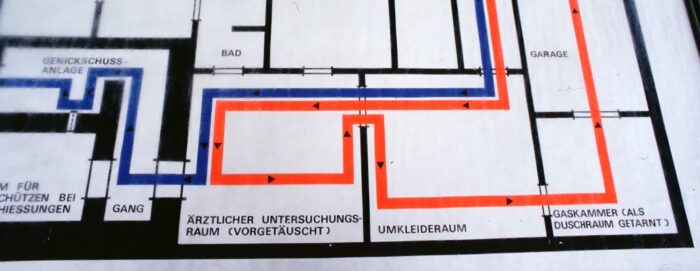
“1) Operations against Poles in 1940 (November 9): during this, 33 Poles were shot; the reason for this were the Bromberg events.”
“2) Operation against Russian prisoners of war in the middle of 1941 (September-October): during this, 16,000 Russian prisoners of war were shot. Every evening, a truck drove in front of the Russian Prisoner of War camp 4 to 5 times, and drove back from there fully loaded to the industrial yard.”
“3) Operation against comrades (communists) of the camp headquarters (writing room): In 1942, on 1 October, these comrades were deprived of their camp functions and taken to the cell block. A few days later, this operation sent 18 of our comrades on transport to the Flossenbürg Penal Camp.”
”4) Operation against Jews. These extended over the entire existence of the concentration camp. Many thousands were exterminated in the process. Some of them were shot in the camp (industrial yard), others were beaten to death at work. The systematic extermination at work mainly involved members of the SS, but also those from the ranks of the prisoners (professional criminals, antisocial prisoners and other bad elements). Jews were also transported to various penal camps for extermination, e.g., Maudhausen [sic], Flossenbürk [sic], Bergenbelzen [sic] and Lublin. Furthermore, at the brick works belonging to the camp, many Jews perished through hunger and cold.”
“5) Operation against homosexuals in 1943”: 100-200 were shot.
“6) Operation against the sick (physically weak and tuberculosis patients): About 3-4 such operations were carried out against them, especially in 1943 and 1944. Transport to Bergenbelzen [sic] and Lublin. Whether the same sick prisoners arrived there and what became of them there is not known to us. Transport Herb Garden and Sun Mountain were fictitious names for camps that did not exist. These prisoners were probably shot or killed in gas cells [sic]. Also, a number of seriously ill prisoners were taken directly to the crematorium belonging to the camp. The number of prisoners who died in this way was in the thousands. In 1945, at the beginning of February, about 1000 prisoners were shot and poisoned in gas cells. This was a Reich measure.”
“7) Operation against unauthorized assumption of authority”: 100 to 200 professional criminals and anti-socials were killed at the end of 1943 and beginning of 1944.
“8) Operation against comrades of the camp headquarters”: 27 prisoners were shot, and 110 were transferred to Mauthausen (towards the middle of 1943).
“9) Operation against the camp in early 1945”: 50 prisoners were executed as dangerous elements.
“10) Small-scale operations from 1940 to 1945”: Punishments and transfers, no murder.
“11) Operation against civilians”: Civilians were shot in the industrial yard, and then burned in the furnaces: “The numbers run into the thousands.”
“12) Operation against terrorists in late 1944 to 1945”: 300-600 partisans were shot.[3]
I will deal with the most essential points of this account – the alleged mass shooting of Soviet prisoners of war as well as the alleged use of a gas chamber for killing people – in the following paragraphs; for the time being, I will limit myself to some remarks of a general character.
According to the witness, the first execution of prisoners at Sachsenhausen took place on 9 November 1940. This circumstance helps us to clarify unambiguously the meaning of an unclear term, which I will do in the following chapter.
It is quite true that transports with sick prisoners left the Sachsenhausen Camp for Lublin: The first – with 3,000 sick prisoners – arrived there on 26 January 1944, the second – with 2,700 sick inmates – arrived on 16 March, and the third – with 500 prisoners – on 22 March. Of course, these inmates were not murdered in Lublin (Majdanek), but were properly registered and housed in the camp hospital.[4] It follows from this that there was no policy of killing sick prisoners at Sachsenhausen, so the claim that thousands of such sick inmates were killed, including 1,000 “shot and poisoned in gas cells” in early 1945, is quite implausible.
The witness states that the alleged homicidal gas chambers (he speaks of “gas cells” in the plural) were used to kill these sick inmates. However, remarkably, he does not mention Jews as gassing victims.
3. Change-in-Occupancy Reports of Sachsenhausen CC
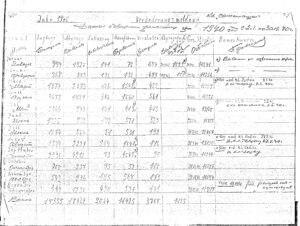
Before I discuss these important points in more detail, I must present the available statistical data concerning the Sachsenhausen Camp’s occupancy and mortality. The change-of-occupancy reports confiscated by the Soviets enable us to obtain the relevant figures for the period from 1940 to 1945 without any gaps. The details can be seen in the tables given below without comment (see Document 1).
| Month | Admissions | Deductions | Releases | Transfers | Deaths | Deducted, unspecified | Total Occupancy | Note | |
|---|---|---|---|---|---|---|---|---|---|
| January | 974 | 1,920 | 141 | 72 | 684 | 1,023* | 31 Jan. | 11,241 | |
| February | 868 | 883 | 150 | 132 | 499 | 102** | 29 Feb. | 11,226 | |
| March | 1,074 | 2,073 | 106 | 1,545 | 422 | 31 Mar. | 10,227 | 1.500 to Dachau CC 4 Mar. 40 | |
| April | 3,677 | 1,927 | 306 | 1,060 | 561 | 30 Apr. | 11,977 | ||
| May | 2,066 | 943 | 121 | 413 | 409 | 29 May | 13,100 | 345 to Neuengamme CC 3 May 40 | |
| June | 1,525 | 996 | 102 | 571 | 323 | 29 June | 11,797[6] | ||
| July | 1,874 | 804 | 81 | 531 | 192 | 31 July | 12,867 | ||
| August | 2,574 | 2,221 | 204 | 1,841 | 176 | 31 Aug. | 13,220 | 1.000 to Dachau CC 27 Aug. 40 | |
| September | 2,236 | 4,212 | 73 | 4,049 | 90 | 30 Sep. | 11,244 | 3.000 to Dachau CC | |
| October | 700 | 257 | 95 | 52 | 110 | 31 Oct. | 11,687 | ||
| November | 543 | 936 | 195 | 568 | 173 | 30 Nov. | 11,294 | ||
| December | 444 | 1,230 | 490 | 591 | 149 | 31 Dec. | 10,577[7] | 14/15 Dec. 1940 missing | |
| Total | 18,555 | 18,402 | 2,064 | 11,425 | 3,788 | 1125 | |||
| * 24 Jan. 1940; ** 9 Feb. 1940 | |||||||||
| Month | Admissions | Deductions | Releases | Transfers | Deaths | Total Occupancy | Note | |
|---|---|---|---|---|---|---|---|---|
| January | 581 | 290 | 121 | 50 | 119 | 2 Jan. 31 Jan. |
10,560 10,868 |
|
| February | 900 | 284 | 124 | 50 | 110 | 28 Feb. | 11,584 | [9] |
| March | 837 | 308 | 102 | 49 | 157 | 31 Mar. | 12,113 | |
| April | 382 | 351 | 124 | 60 | 167 | 30 Apr. | 12,144 | |
| May | 302 | 1,314 | 138 | 1,083 | 93 | 31 May | 11,132 | |
| June | 485 | 521 | 105 | 383 | 33 | 30 June | 11,097 | [10]* |
| July | 642 | 230 | 132 | 62 | 36 | 31 July | 11,509 | |
| August | 404 | 674 | 99 | 537 | 38 | 31 Aug. | 11,239 | |
| September | 479 | 1,186 | 75 | 1,076 | 35 | 30 Sep. | 10,532 | |
| October | 2,777 | 3,034 | 78 | 2,814 | 142 | 31 Oct. | 10,175 | [11]** |
| November | 430 | 231 | 54 | 27 | 150 | 29 Nov. | 10,374 | |
| December | 443 | 108 | 1 | / | 107 | 31 Dec. | 10,709 | |
| Total | 8,662 | 8,531 | 1,153 | 6,191 | 1,187 | |||
| * On 3 June 1941, 95 inmates were transferred without further information according to a separate list. ** On 23 Oct. 1941, 2,436 Soviet PoWs were deducted from the camp occupancy, meaning liquidated in the crematorium. |
||||||||
| Month | Admissions | Deductions | Releases | Transfers | Deaths | Deducted, unspecified (liquidated) |
Total Occupancy | Note | |
|---|---|---|---|---|---|---|---|---|---|
| January | 329 | 702 | 484 | 79 | 139 | 31 Jan. | 10,336 | ||
| February | 400 | 355 | 78 | 63 | 214 | 28 Feb. | 10,381 | ||
| March | 313 | 1,249 | 81 | 737 | 431 | 31 Mar. | 9,445 | ||
| April | 981 | 898 | 216 | 436 | 246 | 30 Apr. | 9,528 | ||
| May | 2,010 | 547 | 75 | 155 | 221 | 96 | 31 May | 10,991 | (1) |
| June | 1,367 | 367 | 43 | 116 | 208 | 30 June | 11,991 | ||
| July | 1,793 | 520 | 51 | 52 | 405 | 12 | 31 July | 13,264 | (2) |
| August | 1,654 | 894 | 73 | 506 | 301 | 14 | 31 Aug. | 14,024 | (3) |
| September | 2,549 | 960 | 180 | 274 | 497 | 9 | 30 Sep. | 15,613 | (4) |
| October | 1,961 | 1834 | 69 | 1,200 | 557 | 8 | 31 Oct. | 15,740 | (5) |
| November | 1,393 | 958 | 137 | 355 | 436 | 30 | 30 Nov. | 16,175 | (6) |
| December | 1,840 | 1,463 | 176 | 728 | 520 | 39 | 31 Dec. | 16,552 | (7) |
| Total | 16,590 | 10,747 | 1,663 | 4,701 | 4,175 | 208 | |||
| (1) 96 Jews were shot at the Industrial Court on 28 May 1942. (2) Deducted, meaning liquidated. (6 July 42: 2; 9 July 42: 3; 13 July 42: 1; 21 July 42: 5; 23 July 42: 1). (3) Deducted 14 (1 Aug. 42: 2; 3 Aug. 42: 1; 8 Aug. 42: 7; 21 Aug. 42: 1; 25 Aug. 42: 3). (4) Deducted 9 (15 Sep. 42: 7; 26 Sep. 42: 1; 30 Sep. 42: 1). (5) Deducted 8 (8 Oct. 42: 1; 20 Oct. 42: 2; 23 Oct. 42: 1; 28 Oct. 42: 2; 31 Oct. 42: 2). (6) Deducted 30 (10 Nov. 42: 1; 20.11,42: 7; 27 Nov. 42: 18; 28 Nov. 42: 4). (7) Deducted 39 (12 Dec. 42: 38; 30 Dec. 42: 1). |
|||||||||
| Month | Admissions | Deductions | Releases | Transfers | Deaths | Deducted † | Total Occupancy | Note |
|---|---|---|---|---|---|---|---|---|
| January | 5,490 | 627 | 109 | 82 | 372 | 64 | 21,415 | |
| February | 960 | 1458 | 48 | 846 | 559 | 5 | 20,917 | |
| March | 1,830 | 975 | 74 | 137 | 669 | 95 | 21,772 | |
| April | 2,497 | 846 | 78 | 78 | 593 | 97 | 23,423 | |
| May | 1,794 | 547 | 69 | 143 | 334 | 1 | 24,670 | |
| June | 684 | 527 | 152 | 134 | 227 | 14 | 24,873 | [14] |
| July | 1,461 | 524 | 96 | 222 | 201 | 5 | 25,750 | |
| August | 1,559 | 475 | 100 | 183 | 182 | 10 | 26,834 | |
| September | 810 | 412 | 85 | 190 | 125 | 12 | 27,232 | |
| October | 883 | 457 | 85 | 266 | 100 | 6 | 27,658 | |
| November | 784 | 222 | 56 | 52 | 106 | 8 | 28,220 | |
| December | 1,259 | 1,264 | 112 | 1,054 | 95 | 3 | 28,224 | [15] |
| Total | 20,011 | 8,334 | 1,064 | 3,387 | 3,563 | 320 |
| Month | Admissions | Deductions | Releases | Transfers | † (Deaths) |
Deducted | Escapes | Missing | Total Occupancy |
|---|---|---|---|---|---|---|---|---|---|
| January | 601 | 736 | 90 | 541 | 105 | / | / | 28,089 | |
| February | 486 | 287 | 99 | 99 | 78 | 9 | 2 | 28,288 | |
| March | 881 | 798 | 96 | 588 | 104 | 3 | 7 | 28,371 | |
| April | 2,099 | 590 | 120 | 152 | 310 | 2 | 6 | 29,880 | |
| May | 922 | 1,329 | 85 | 1,060 | 178 | / | 6 | 29,478[17] | |
| June | 4,522 | 870 | 95 | 529 | 108 | 113 | 25 | 33,130 | |
| July | 4,720 | 3,767 | 85 | 3,568 | 105 | 6 | 3 | 34,083 | |
| August | 6,940 | 3,320 | 103 | 2,040 | 161 | / | 15 | (1) | 37,703 |
| September | 10,496 | 3,160 | 906 | 2,030 | 183 | 2 | 16 | (2) | 45,039 |
| October | 7,771 | 6,910 | 279 | 6,430 | 193 | / | 8 | 45,900 | |
| November | 5,699 | 6,857 | 194 | 6,393 | 268 | 1 | 1 | 44,472 | |
| December | 5,428 | 2,476 | 197 | 1,699 | 573 | / | 7 | 47,565[18] | |
| Total | 50,565 | 31,100 | 2349 | 25,129 | 2,366 | 136 | 96 | ||
| (1) 1 unspecified. 1000 (illegible) inmates. Taken off (illegible); (2) 23 inmates transferred at police. | |||||||||
| Month | Admissions | Deductions | Releases | Transfers | † (Deaths) |
Deducted | Escapes | Missing | Total Occupancy |
|---|---|---|---|---|---|---|---|---|---|
| January | 12,489 | 3,324 | 136 | 2,025 | 1,138 | 8 | 17 | / | 58,147 |
| February | 945 | 11,708 | 42 | 8,811 | 2,832 | 1 | 22 | / | 37,883[20] |
| March | 3,539 | 6,491 | 72 | 5,885 | 359 | 1 | 160 | 14 | 34,931[21] |
| April | 840 | 1,198 | 28 | 530 | 492 | 1 | 96 | 51 | 36,654[22] |
| Total | 17,813 | 22,721 | 278 | 17,251 | 4,821 | 11 | 295 | 65 |
| Month | Admissions | Deductions | Releases | Transfers | Deaths | Deducted | Escapes | Missing | Deductions, unspecified |
|---|---|---|---|---|---|---|---|---|---|
| 1940 | 18,555 | 18,402 | 2,064 | 11,425 | 3,788 | / | / | 1,125 | |
| 1941 | 8,662 | 8,531 | 1,153 | 6,191 | 1,187 | / | / | / | |
| 1942 | 16,590 | 10,747 | 1,663 | 4,701 | 4,175 | 208 | / | / | |
| 1943 | 20,011 | 8,334 | 1,064 | 3,387 | 3,563 | 320 | / | / | |
| 1944 | 50,565 | 31,100 | 2,349 | 25,129 | 2,366 | 136 | 96 | 1024 | / |
| 1945 | 17,813 | 22,721 | 278 | 17,251 | 4,821 | 11 | 295 | 65 | / |
| Totals | 132,196 | 99,835 | 8,571 | 68,084 | 19,900 | 675 | 391 | 1,089 | 1,125 |
4. The Living and the Dead
The column headings listed in the change-of-occupancy reports can be interpreted without major difficulties:
- “Admissions” refer to prisoners who arrived at the camp and were registered there.
- “Deductions” refer to prisoners who had disappeared from the camp population. In the relevant column, the total number of departures is reported, and the subsequent columns provide information on the respective reasons.
- The term “Releases” is self-evident.
- “Transfers” indicates a transfer to another location.
- “Deaths” refers to camp inmates who died of natural causes.
- “Deducted, unspecified” is a synonym for “liquidated”, as can be inferred from the change-of-occupancy report for 1942.
- Also, “Deducted †” is to be regarded as synonymous with killed. This circumstance is corroborated by the change-of-occupancy report for 1943, where a cross is written under this expression, just as under “Deaths”. That “Deducted” cannot have the meaning of escapes, as one would initially assume (the reflexive term “sich absetzen” means to abscond), is evident from the fact that, in the statistics for 1944 and 1945, separate columns are kept for “Deducted” and “Escapes.”
- “Deductions without indication” undoubtedly includes transfers as well as dismissals for which the documentary records had not been kept. That this heading also refers to killings can be ruled out, since a killing of 1,023 prisoners on January 24, 1940, and one of 102 prisoners on February 9 of the same year are not claimed either by the most detailed eyewitness accounts or by official historiography. As we have seen, according to the witness Koehlen, the first mass killing did not take place until 9 November 1940.
On 1 January 1940, there were (11,241 – 974 + 1,920 =) 12,187 inmates in the camp.
Therefore, (132,196 – 12,187 =) 120,009 inmates were admitted into the camp between January 1940 and April 1945.
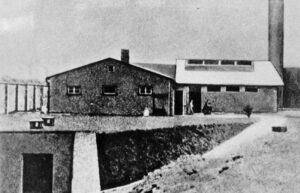
On January 1, 1940, there were (11,241 – 974 + 1,920 =) 12,187 prisoners in the camp.
From January 1940 to April 1945, therefore, (132,196 – 12,187 =) 120,009 prisoners were admitted to the camp.
During the same period, 8,571 prisoners were released, 69,084 were transferred, 19,900 died of natural causes, 675 were executed or liquidated (with or without sentence), 391 escaped, 1,089 were in all probability ordered out of the camp by local police authorities, and 1,125 were transferred or set at liberty “without indication.”
The question of the fate of Soviet POWs is addressed in the following chapter.
According to the Encyclopedia of the Holocaust,[23] Sachsenhausen Camp had an average strength of 2,000 prisoners at the end of 1936; at the end of 1937, according to the same source, the camp strength was 2,523, 8,309 in 1938, and 12,168 in 1939. According to this source, 450 Jewish inmates were killed in 1938,[24] and 800 inmates are said to have died in 1939. We consider these figures to be exaggerated and especially do not believe in the killing of 450 Jews in 1938, particularly since Raul Hilberg, in his standard work on the “Holocaust,” knows nothing about such an extensive killing campaign in the pre-war period. We consider more credible the figures provided by Winfried Meyer with reference to documents (inaccessible to us) of the Sachsenhausen Memorial in the Zeitschrift für Geschichtswissenschaft:[25]
- 1936: 6 Deaths
- 1937: 38 Deaths
- 1938: 229 Deaths
For 1939, W. Meyer does not give a casualty figure.
Regarding the total number of victims, the Encyclopedia of the Holocaust states:[23]
“In addition to the Soviet prisoners of war executed on arrival and those prisoners who died en route to and from the camp and during its evacuation, some 30,000 persons perished in Sachsenhausen.”
In reality, as we have already noted, 19,900 prisoners died of natural causes from 1940 to 1945. If one accepts the total number of 1,250 prisoners killed or perished in 1938 and 1939, as supplied by the Encyclopedia of the Holocaust, one thus arrives at approximately 21,200 deaths for the period from 1938 to 1945. If, on the other hand, one accepts W. Meyer’s figures, the number of victims for the entire period of the camp’s existence (except 1939) amounts to (6 + 38 + 229 + 19,900 =) 20,263.
5. Soviet PoWs
The Encyclopedia of the Holocaust reports the following on the subject of Soviet prisoners of war:[23]
“At some point, probably in August 1941, the SS set up an installation for mass executions by shooting, disguising it as a prisoners’ examination room. In the following months, 13,000 to 18,000 Soviet prisoners of war, who were not even registered in the camp’s lists, were murdered there.”
At first glance, this assertion seems to be at least partially corroborated by a handwritten note in the change-of-occupancy report for the year 1941, which reads as follows:
“On 23 Dec. 41, 2,436 Russian PoWs deducted from camp occupancy, i.e., liquidated in the crematorium.”
But the statement “i.e., liquidated in the crematorium” is demonstrably incorrect. In fact, there is a document on the fluctuations in the number of Soviet prisoners of war in the period from 18 October (on that day, the first transport with such prisoners arrived) to 30 December 1941 (see Doc. 2). On 23 October, there were 2,436 Soviet prisoners of war in the Sachsenhausen Camp, regarding whom the following typewritten entry appears: “as of 23 Oct. 41 no longer in camp strength”. Since the document also notes the changes in the number of Soviet POWs for the following period (2,423 on 24 October, 1,360 on 30 December), it is clear that these 2,436 allegedly liquidated prisoners were no longer listed in the occupancy book. In fact, they belong to those 2,814 prisoners who, according to the change-of-occupancy report for October 1941, are registered under the heading “Transfers.” As of 24 October, Soviet prisoners of war were recorded in a separate occupancy book; hence, they were counted separately.

6. Homicidal Gas Chamber
According to the orthodox narrative,[26] there was a gas chamber for killing people in Sachsenhausen Camp. The Encyclopedia of the Holocaust expresses itself quite succinctly on this subject:[23]
“The camp also has a gas chamber, probably installed in 1943; it was added to an existing crematorium compound. The gas chamber was used on special orders only; one such occasion, presumably, was in February 1945. When the SS had several thousand physically debilitated prisoners killed on the eve of the camp’s evacuation.”
Further details about the alleged homicidal gas chamber at Sachsenhausen are given by another classic of official historiography, the anthology Nazi Mass Murder, in the brief section devoted to this camp:[27]
“The former commandant of the camp, one Anton Kaindl, who had run it from August 1942 until it was dissolved in 1945, declared in his depositions that Richard Glücks, the inspector of concentration camps, had ordered the commandants of the various camps to have gas chambers built on the model of those at Auschwitz.”
Subsequently, this book quotes an excerpt from the transcript of the Sachsenhausen Trial before the Military Tribunal of the Soviet Occupation Forces in Germany from 23 October to 1 November 1947, during which the accused Sachsenhausen commandant Anton Kaindl “confessed:”[29]
“About the middle of March 1943, I introduced the gas chamber as a means of mass extermination.”
Kaindl further stated:[30]
“In 1942, by order of the Inspector of the SS concentration camps, Glücks, so-called ‘gas chambers’ were used on a large scale in the German camps to kill people. In 1943, I decided to build a gas chamber[s] at my place for the mass killing of prisoners. I received construction personnel from the SS Main Office, who in the fall of 1943 completed the installation of the gas chamber on the grounds of the camp in the crematorium building.”
This confession is implausible for a number of reasons. First, in the original, Kaindl speaks of “gas chambers” in the plural, although official historiography speaks only of one gas chamber. Second, as we will soon see, the alleged gas chamber would have been far too small for mass extermination. Third, Glücks’ order, to which Kaindl refers, is a pure invention. Fourth, the construction personnel for the erection of a homicidal gas chamber would have been provided by the SS construction office of the Sachsenhausen Camp, and not by the SS main office.[31]
At the trial against Kaindl just mentioned, the prosecutors were rather imprudent by describing the structure of the “gas chamber” rather accurately:[32]
“During the trial both Kaindl and a former prisoner, Paul Sakowski, who had worked in the crematorium complex as an executioner and had witnessed gassings, gave descriptions of the gas chamber. It had a device for opening containers automatically, and a ventilator equipped with a pressure fan was installed on the outside wall. The container was set in place, it was opened mechanically, and the fan blew the gas into the room through a system of heated pipes. That is why the SS men did not need gas masks as Sachsenhausen, as they did in most of the other camps.”
This description already indicates what this alleged homicidal gas chamber was in reality, but we have an incredibly important document that removes any doubt. Before we turn to this document, however, we want to emphasize that orthodox historiography is significantly ignorant of the construction and use of this chamber. In Nazi Mass Murder, these historians admit unabashedly:[33]
“The depositions differ as to the date of construction. […] At present, our lack of specific, incontrovertible evidence makes it impossible to give a figure, even an approximate one, for the number of those executed at Sachsenhausen by means of poison gas.”
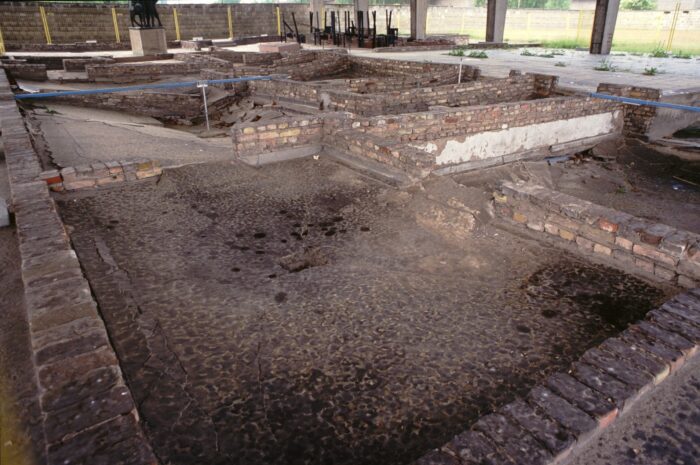
7. Soviet Expert Report on the Gas Chamber
Between June 10 and 22, 1945, a Soviet commission of experts, consisting of Colonel Vlochin and the engineers Teljaner and Grigorev, examined the Sachsenhausen Camp’s crematorium together with the killing facilities allegedly attached to it (gas chamber and execution room). Subsequently, the experts prepared an expert report accompanied by drawings. With regard to the alleged homicidal gas chamber, it states:[34]
“Gas chamber.[35]
It is a rectangular room measuring 2.75 x 3 m, with two entrances: one from the garage, the other from the undressing room. 1.5 m above the floor, on the northwest wall, there is a small window measuring 75 x 100 cm, which has a pane of bulletproof glass and is protected by a metal grille. On the northeast wall, 2.20 m above the floor, a fan is installed to ventilate the room; there is also a small window with bulletproof glass panes and a metal grille. All four walls are covered with fine tiles up to a height of one and a half meters. On the walls as well as on the ceiling there is a water pipe with six shower heads. The floor is made of cement. There is an opening in the floor that allows the water to drain.
During a detailed inspection of the wall of the gas chamber adjacent to the garage, traces of a closed opening were found where the metal apparatus for evaporating the hydrogen-cyanide gas examined during the technical investigation had been installed. This apparatus [see Doc. 3] consisted of a hermetic chamber, an electric device for heating the air, a fan for introducing hot air, and a connecting tube. The introduction of hydrogen-cyanide vapors into the gas chamber was done in the following way: A small Zyklon ‘A’ bottle was placed in the chamber, 30% of which was filled with hydrogen-cyanide gas. The capacity of the container was 150 grams.
Remark. Seven containers with hydrogen cyanide gas – the preparation Zyklon ‘A’ – were found in the building of the crematorium in a niche of the morgue, near the execution facility. In the same place, a large number of broken containers with Zyklon ‘A’ were found.
One such container was opened with the help of a bottle opener, and by means of heating the air in the electric device, the hydrogen-cyanide vapors were passed through a metal grate […an illegible word follows] into the room of the gas chamber.”
The installation described and drawn by the Soviet experts was certainly a Degesch circulation chamber used for fumigations with Zyklon B, here adapted to the room in question. A comparison between the Soviet drawing (cf. Doc. 3) and the drawing of a Degesch circulation device removes any doubt about this (cf. Doc. 5).
Since it was not possible to install a fan in the ceiling of the room described, the Degesch circulation system was modified so that the two essential functions of the fan were performed by two fans inside the room (see Doc. 4): the first, a circulation fan (7), was mounted on the floor and terminated in an open tube for dissipating the air (8); the second, a ventilating fan (9) was installed on the ceiling and connected to a chimney located outside the room. The Zyklon-B container was inserted into the gas-tight opening device designed for this purpose, from which the Zyklon-B granules fell onto a net (4) located underneath; a radiator (5) was placed under this, which accelerated the evaporation of the hydrogen-cyanide gas.
The fan (7) placed on the floor sucked in the gas mixture through the connecting tube (6) and spread it throughout the room through the corresponding tube (8). In the opposite corner of the room was the opening (10) of a suction pipe (11), which was connected to the opening device for the Zyklon-B cans. Due to the negative pressure caused by the fan, the gas mixture was sucked in by this apparatus through the opening as well as the net on which the Zyklon-B granules were lying, and exited through the pipe all over again.
With each passage, the gas mixture heated up and accelerated the evaporation of the hydrogen-cyanide gas. This system ensured the circulation of the gas mixture, which was the central principle of the Degesch circulation system. After the disinfestation operation was completed, the external opening device (3) was operated, which pulled out the Zyklon-B can; then the connection of the vertical suction tube with this device (12) was closed, and both fans were put into operation. In this way, the circulation fan drew in fresh air from outside, while the exhaust fan expelled air from the room.
Theoretically, this disinfestation chamber – like any similar facility in any other concentration camp – could certainly have been used to kill people, but its size (2.75 m × 3 m = 8.25 m²) makes a mockery of Kaindl’s claim that it was used “for the mass killing of prisoners.”
The Soviet experts’ statement that the gas chamber was operated with Zyklon A containers is even more abstruse. By the beginning of the 1930s, the original Zyklon product (called Zyklon A only after the introduction of the later Zyklon B) had already been discontinued, and, moreover, was not stored in “containers” at all. A disinfestation expert, Gerhard Peters, stated in this regard in 1933:[36]
“The method of application of ‘Zyklon A’ was externally extraordinarily simple: it only needed to be injected into the room to be disinfested with a device similar to plant-sprayer under 5-10 atmospheres of pressure by means of a metallic or other conduit (such as through the keyhole) and finely vaporized.”
Thus, the use of Zyklon A required a vaporizer that could not be achieved at all with a simple fan. It follows that the use of this product would have been technically impossible with the Sachsenhausen fumigation chamber.
8. Homicidal Gassings at Sachsenhausen: A False Testimony
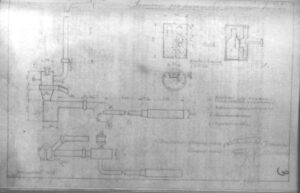
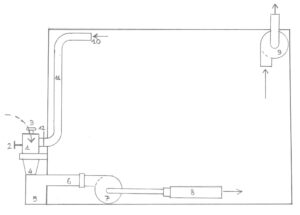
1) Zyklon-B-can opening device; 2) can opener; 3) lid of device; 4) net for collecting Zyklon B granules; 5) heater; 6) connecting tube; 7) circulation fan; 8) diffusion tube; 9) venting fan; 10) suction tube mouth; 11) suction tube; 12) suction tube closing flap.
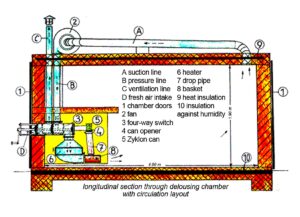
“The door was closed from the cloakroom side, where the defendant stood with the other participants. Wessel turned on the pressure fan, which was placed near the floor on the wall between the cloakroom and the gas chamber. Then he had someone – the defendant does not know whom – hand him a capsule, which the defendant knew contained liquefied gas, and he inserted it into the center of the fan. A moment later he stopped this fan and turned on an exhaust fan set into an outside wall of the gas chamber. After the chamber had been sufficiently ventilated, the door was opened, and the defendant saw the prisoners asphyxiated by the gas. The doctor present made sure they were dead.”
One does not quite understand why the eight or nine inmates condemned to death were not shot in the alleged execution room of the crematorium or at the firing range. On the other hand, it is clear that the witness never saw the events he described. His description is based on the fraudulent Soviet expertise on gassings with Zyklon A, since he speaks of a “capsule” which contained “liquefied gas”. The witness adds that the capsule was “inserted into the center of the fan,” which is nonsense, because it would have had to be inserted into the can opener designed for that purpose. Finally, the ventilator (“exhaust fan”) could not perform its task, i.e.. pumping out the air, if the circulation ventilator was switched off (in the German original text, the witness calls it a “Druckventilator,” meaning “pressure ventilator”).
9. The Destruction of the “Evidence”
When the Soviets liberated the Sachsenhausen Camp, the crematorium was practically intact. Even the furnaces were still in place, and had been drawn with great precision by Soviet experts.[40] (Cf. Figure 4.) The Sachsenhausen Memorial and Museum website reports the following about the camp’s subsequent postwar history:[41]
“In connection with the Allied denazification policy, the Soviet occupying power set up ten special camps in the Soviet Occupation Zone (SBZ) after the military defeat of the Nazi regime. With 60,000 prisoners, Special Camp No. 7 (since 1948 No. 1) in Sachsenhausen was by far the largest of these camps. 12,000 people died here of hunger and disease between 1945 and 1950. In particular, the reduction of the already scarce rations led to a veritable mass death in the ’Hunger Winter‘ of 1946/47.”
“Since the Soviet occupation forces used the former concentration camp complex, commemorating the victims at the authentic site was not possible at first. The first commemorative events therefore took place in Oranienburg’s city center in the immediate post-war period. Furthermore, with the takeover of the site by the Kasernierte Volkspolizei (KVP, Communist East Germany’s army-style police force) in 1950, the neglect and destruction of historic structures began. […]
In 1952/53, the former extermination site ‘Station Z’ was demolished by the KVP, which planned a ‘shooting range’ in this area, of all places. The local population also participated in the destruction by using barracks from the former prisoners’ camp area as construction material and firewood. [Communist East Germany’s] National People’s Army (Nationale Volksarmee) […] participated in destructions on the site. The prisoners’ camp was ‘historically cleansed’ as far as possible.”
Thus, under the Soviet regime, 12,000 out of 60,000, or 20% of the Germans imprisoned there died in Sachsenhausen during peacetime. During the Nazi regime, in seven and a half years – five of which were war years – 21,200 prisoners had perished, representing 16% of the internees.
The destruction of the crematorium by the Communist police force, which could not have been carried out without orders from above, seems more than strange when one considers that Communist East Germany always saw itself as the guardian of the holy grail of “anti-fascism”. One conceivable explanation would be that prisoners had been murdered in the crematorium by NKVD agents, and that the government of Communist East Germany later wanted to cover the traces of these misdeeds. In 1961, a memorial was erected on the site where the crematorium had stood, with the following inscription on the plaque (see Fig. 5):
“‘Station Z’ – foundation of the crematorium built in 1942 with 4 furnaces, a gas chamber and a neck-shooting device”.
Well, the crematorium, together with its “gas chamber” and its “neck-shooting device,” have disappeared forever, but the National Socialists are not to blame for that!

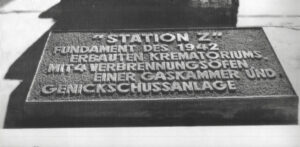
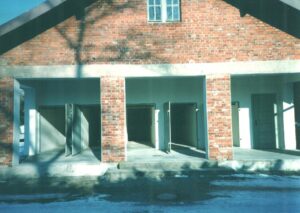
10. Excursus: The Gas Chamber at Mauthausen
In the previous chapter, we provided evidence that the gas chamber of Sachsenhausen Camp was a Zyklon-B fumigation chamber with an adapted Degesch circulation system. The fact that it was located in the crematorium had no sinister significance, because five Degesch circulation fumigation chambers of the standard type were also installed at the Dachau Camp in the same building as the cremation furnaces, and any gassing of prisoners in these chambers is not claimed by anyone (see Fig. 6).
The Sachsenhausen fumigation chamber had two doors: one for the “unclean side,” from which the material to be fumigated was brought in, and one for the “clean side, from which the disinfested objects were taken out.
The room described in the Soviet report as a homicidal gas chamber had a real water pipe with six real showers. To allow the water to drain, a drain was placed on the floor. The walls were covered with tiles up to a height of one and a half meters. The size of the room was quite small: 2.75 m × 3 m = 8.25 m².
All this can be found with striking similarity in the alleged homicidal gas chamber at the Mauthausen Camp! This room, located next to the crematorium,[42] has two gas-tight doors, a real water pipe and sixteen real showers, a drain for draining the water, and the walls are covered with tiles up to a height of about one and a half meters. This room is also quite small (3.59 m × 3.87 m = 13.98 m²); its height is 2.42 m.[43] Furthermore, it contains a heating radiator consisting of five horizontal tubes (cf. Figs. 7ff.).
According to Hans Marsalek, during his lifetime one of the leading orthodox Mauthausen historians, this room was a homicidal gas chamber that functioned in a decidedly peculiar manner:[44]
“On one side of the wall, above the tiles, there was a radiator; furthermore, there was lighting; in one of the ceilings there was an electric ventilation (5) and an approximately 1 m long enameled pipe (6). On the side of the wall, not visible, this pipe, had a half centimeter wide and 80 cm long slit opening, and was connected with the gas filling device (3) located in the gas cell (2). All switches (7) – for light, water supply and ventilator – were located outside the gas chamber (1). The hot brick was brought in on a shovel, and placed on the bottom of the gas filler. Now, the SS man wearing a gas mask poured the Zyklon-B poison from the can onto the brick. Immediately, the container was fitted with the sealed lid, and closed airtight by means of two existing wing screws. The rising heat of the heated brick caused the rapid release of the poison.”
Fig. 7-12: Details of the shower room at the Mauthausen Concentration Camp, erroneously labeled “homicidal gas chamber”. All photos © Carlo Mattogno. Click on photo to enlarge.

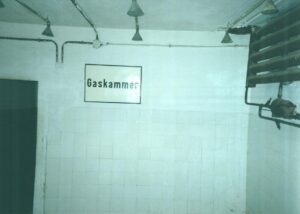
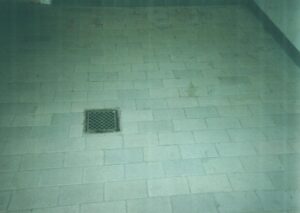



In a different book, the same author wrote:[45]
“If there was enough gas in the chamber, death by asphyxiation occurred in about 10 to 20 minutes. […] The entire process of gassing, of a group of about 30 persons, beginning with undressing, the so-called medical examination, murder, ventilation and removal of the corpses, lasted 1 1/2 to 2 1/2 hours.”
Such a system would have been primitive, dangerous and inefficient. Pouring a can of Zyklon B granules on a brick heated in the nearby crematorium would have immediately produced a plume of hydrogen-cyanide fumes (just as pouring water on the hot brickwork of a furnace produces vapor), and the fumes would have spread through the basement of the infirmary, which had no ventilation system.
On the other hand, the following should be noted: According to the orthodox narrative, in the alleged homicidal gas chambers of the Birkenau crematoria, which had no means of heating the Zyklon B, all victims are said to have been dead after just a few minutes – 20 at most.”[46] Under these circumstances, one does not understand why a heated brick and a gas filler were necessary at Mauthausen, all the more so since the room had a hot-water radiator, and this heating system could have been used to accelerate the evaporation of the hydrogen-cyanide gas.
Last but not least, to ventilate the gas chamber effectively, it would have been necessary to open one of the two doors or even both, because venting by sucking the air out of the “gas cell” through the “gas filling device” and the 80 cm long but only half a centimeter wide “slit opening” in the pipe would have taken far too long.
And all this effort is said to have been made in order to gas thirty prisoners who could have been shot much more quickly and without any difficulty! Moreover, no one understands why a gas chamber should have been equipped with a functioning shower and heating system. The story does not add up.
Finally, the following seemingly peculiar fact is worth mentioning: On none of the official plans of Mauthausen Camp does a disinfestation plant appear. Can one really imagine that the main camp had to manage without such an important facility, and had to rely on the corresponding facility at the Gusen Subcamp?[47]
On the other hand, the similarity between the disinfestation chamber at Sachsenhausen and the alleged homicidal gas chamber at Mauthausen is all too striking to be a mere coincidence. Quite obviously, both were rooms that had previously served other purposes and had then been converted into premises with a dual function as a disinfestation chamber and shower room. The chamber at Mauthausen was certainly equipped with a modified Degesch circulation system similar to that at Sachsenhausen. The device for opening the Zyklon B cans was located in the adjacent room (today called the “gas cell”), and in front of it, inside the room, the circulation fan with the corresponding tubes was installed on the floor. The ventilator was located in the opposite corner in the ceiling, where one can still see its opening closed by a round lid, and was connected to a shaft located on the roof of the room, so the hydrogen-cyanide gas exited at a level not dangerous for humans (see Fig. 11f.).
Therefore, there is no doubt that we are dealing here with a hydrogen-cyanide fumigation chamber with a Degesch circulation system.
This provides a plausible explanation for the fact that no known plan of Mauthausen Camp shows a disinfestation chamber, and that no original plan of this camp has ever been published. Finally, it also explains the fact that cyanide concentrations of a maximum of 32 mg/kg were measured in the mortar samples taken from this location by Fred Leuchter.[48] This value is sufficiently high to prove that hydrogen cyanide was indeed used in this room, but it is far below the values determined in the Zyklon-B fumigation buildings BW 5a and 5b at Birkenau, because the hydrogen cyanide at Mauthausen was used with a circulation system, leading to much shorter exposure times.
Of course, this fumigation chamber could have been misused for homicidal purposes, but no testimony describes the circulation system, which would have been the only system allowing this facility to function.
Notes
First published in Vierteljahreshefte für freie Geschichtsforschung, Vol. 7, No. 2, 2003, pp. 173-185.
| [1] IMT, Vol. VII, p. 586. |
| [2] Affidavit by P. Waldmanns dated 20 June 1945. GARF (Gosudarstwenny Arkhiv Rossiskoi Federatsii, State Archives of the Russian Federation), Moscow, 7021-104-8, p. 24a (p. 6 of the affidavit). |
| [3] GARF, 7021-104-2, pp. 52-55. |
| [4] Jürgen Graf, Carlo Mattogno, Concentration Camp Majdanek: A Historical and Technical Study. 3rd ed., Castle Hill Publishers, Uckfield, 2016, p. 44. Z. Leszczyńska, “Transporty więźniów do obozu Majdanku,” in: Zeszyty Majdanka, Vol. IV, 1969, p. 207. |
| [5] GARF, 7021-104-4, p. 39. |
| [6] Total miscalculated: (13,100 + 1,525 – 996 =) 13,629. |
| [7] Total miscalculated: (11,294 + 444 – 1,230 =) 10,508. |
| [8] GARF, 7021-104-4, p. 50. |
| [9] Total miscalculated: (10,868 + 900 – 284 =) 11,484. |
| [10] Total miscalculated: (11,132 + 485 – 521 =) 11,096. |
| [11] Total miscalculated: (10,532 + 2,777 – 3,034 =) 10,275. |
| [12] GARF, 7021-104-4, p. 58. |
| [13] GARF, 7021-104-4, p. 65. |
| [14] Total miscalculated: (24,670 + 684 – 527 =) 24,827. |
| [15] Total miscalculated: (28,220 + 1,259 – 1,264 =) 28,215. |
| [16] GARF, 7021-104-4, p. 73. |
| [17] Total miscalculated: (29,880 + 922 – 1,329 =) 29,473. |
| [18] Total miscalculated: (44,742 + 5,428 – 2,476 =) 47,694. |
| [19] GARF, 7021-104-4, p. 81. |
| [20] Total miscalculated: (58,147 + 945 – 11,708 =) 47,384. |
| [21] Total miscalculated: (37,883 + 3,539 – 6,491 =) 34,931. |
| [22] Total miscalculated: (34,873 + 840 – 1,198 =) 34,515. |
| [23] I. Gutman (ed.), Enzyclopedia of the Holocaust. Yad Vashem, Jerusalem 1990, Vol. 3, p. 1321. |
| [24] Leni Yahil was more careful; he wrote that 300 Jews “perished” in 1938. L. Yahil, “Jews in Concentration Camps in Germany prior to World War II,” in: The Nazi Concentration Camps. Yad Vashem, Jerusalem, 1984, p. 94. |
| [25] Winfried Meyer, “Britischer oder sowjetischer Sachsenhausen-Prozeß?,” in: Zeitschrift für Geschichtswissenschaft. No. 45, 1997, p. 987. |
| [26] More specifically, according to some orthodox “Holocaust” historians. Raul Hilberg mentions homicidal gassings at Sachsenhausen nowhere in his magnum opus The Destruction of the European Jews; Translator’s note. |
| [27] Eugen Kogon, Hermann Langbein, Adalbert Rückerl (eds.), Nazi Mass Murder: A Documentary History of the Use of Poison Gas. Yale Univ. Press, New Haven/London, 1993, p. 184. |
| [28] GARF, 7021-104-4, pp. 149f. |
| [29] Kogon et al., op. cit. (Note 27), p. 184: the original in fact reads “gas chambers,” plural, which the translators of the English edition “corrected.” |
| [30] Ibid., pp. 184f. |
| [31] The Sachsenhausen Camp was subject to the Construction Inspection of the Waffen SS and Police, Reich North, which supervised three central construction offices (Berlin, Ravensbrück and Goslar) as well as 11 construction offices, among them also that of Sachsenhausen. |
| [32] Kogon et al., op. cit. (Note 27), p. 255. |
| [33] Ibid., pp. 270, 186. |
| [34] GARF, 7021-104-3, pp. 2-4. |
| [35] GARF, 7021-104-3, p. 7: Blueprint of the Sachsenhausen Camp’s crematorium. Soviet drawing (of June 1945), there No. 2. This document has such a bad quality that we cannot reproduce it here. It will be posted online. |
| [36] Gerhard Peters, Blausäure zur Schädlingsbekämpfung. Sammlung chemischer und chemisch-technischer Vorträge. Ferdinand Enke, Stuttgart, 1933, p. 57. |
| [37] GARF, 7021-104-3, p. 23. |
| [38] Ludwig Gaßner, “Verkehrshygiene und Schädlingsbekämpfung”, Gesundheits-Ingenieur, Vol. 66, No. 15, 1943, pp. 174ff. |
| [39] Kogon et al., op. cit. (Note 27), p. 185. |
| [40] GARF, 7021-104-3, pp. 5f. |
| [41] https://www.sachsenhausen-sbg.de/geschichte/1945-1950-sowjetisches-speziallager/ and https://www.sachsenhausen-sbg.de/geschichte/1961-1990-nationale-mahn-und-gedenkstaette-sachsenhausen/ |
| [42] Just like the Topf double-muffle furnaces, this room is also located in the basement of camp hospital. |
| [43] Measures taken on the spot by the author. |
| [44] Hans Marsalek, Die Vergasungsaktionen im Konzentrationslager Mauthausen. Österreichische Lagergemeinschaft Mauthausen, Vienna, 1988, p. 10. |
| [45] Hans Marsalek, Die Geschichte des Konzentrationslagers Mauthausen. Dokumentation. Österreichische Lagergemeinschaft Mauthausen, Vienna, 1980, p. 211. |
| [46] F. Piper, “Gas Chambers and Crematoria,” in: Y. Gutman, M. Berenbaum (eds.), Anatomy of the Auschwitz Death Camp. Indiana University Press, Bloomington/Indianapolis, 1994, p. 170. |
| [47] The Gusen Camp had a Zyklon-B fumigation chamber with an extraction fan. |
| [48] Fred Leuchter, Robert Faurisson, Germar Rudolf, The Leuchter Reports: Critical Edition, Castle Hill Publishers, Uckfield, 2017, p. 143. |
Bibliographic information about this document: Inconvenient History, Vol. 15, No. 2, 2023; first published in Vierteljahreshefte für freie Geschichtsforschung, Vol. 7, No. 2, 2003, pp. 173-185.
Other contributors to this document: n/a
Editor’s comments: n/a
